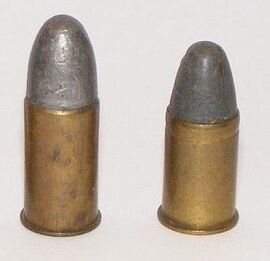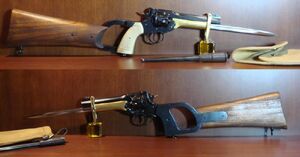The Webley Self-Extracting Revolver was a British service revolver used for over 75 years across the British Empire and Commonwealth. Chambered in the .455 Webley cartridge, one of the most potent military cartridges ever produced, and designed to be used in harsh conditions reliably the Webley (as it became more commonly known) would replace various older multiple barrel sidearms favoured by British Officers (eg the Lancaster Pistol).
Design Details
The Webley Revolver was designed with a brand new (in the 1880's) extractor system, designed to push the spent cartridges out of the cylinder when the Webley was broken (as the Webley was a top-break revolver). This system consisted of an umbrella shaped pin which would unfold as the barrel/cylinder were pulled away from the frame via a hinge.
The Webley was manufactured as a double action revolver, intended to replace the much more bulky Enfield Revolvers. Webley, having originally built several Smith & Wesson revolvers underlicense, used the same double action system that they (Smith & Wesson) had designed, combining it with the basic hinged frame that Webley had pioneered the use of.
Safety was not considered a key feature of the original Webley design, meaning that the only even remote safety system installed on the Webley is the lever which locks the barrel/cylinder to the frame after the Webley has been loaded. Even this is not a genuine safety mechanism, its only real purpose is to ensure that the frame is securely held around the cylinder.
Ammunition
The Webley Revolver was chambered for the .455 Webley, a cartridge designed for stopping power over more modern cartridges. The original .455 Webley used a soft lead bullet which would deform when the cartridge was fired to engage with the rifling, however, with the intervention of the Hague Convention of 1907 (which declared that the use of deforming bullets was illegal in the theatre of war), the .455 Webley was converted to a Full-Metal-Jacket (FMJ) cartridge, which meant it was less efficent than the original .455 Webley. As a result the newer .455 Webley would not engage with the rifling of the Webley Revolver properly, causing shots to spin out of control.

Two .455 Webley cartridges
Webley also began to develop the use half-moon and full-moon clips as well as speed loaders for the first time with the Webley Revolver.
Variants
The Webley Revolver would evolve as its service life grew, as Webley recognised that their design would have to develop to prevent the British Army from choosing another service pistol/revolver. As such the Webley would appear in six different editions over the 76 years of its use.
Webley Mk I
The Webley Mk I, being the first version of the Webley to be adopted by the Army, was seen as a vast improvment over the older Enfield and Beaumont Adams revolvers. It featured all of the afore mentioned design elements with a birds head shaped grip.
The Mk I* was a version of the Mk I which featured upgrades to bring the Mk I to the standards of the Mk II when that became standard issue. 10,000 Mk Is were ordered following its adoption by the Army in 1887.
Webley Mk II
Being adopted in 1895 with various refinements made to the original design. Among the changes made to the Mk II a newly shaped hammer and hardened steel blast shield were added, along with a new 100mm (4in) barrel. A change in the shape of the grip was also made.
Webley Mk III
The Mk III was identical to the Mk II, being adopted two years later in 1897. The only major changes were made to the cylinder cam and its various mechanisms, however these improvments would not make a significant impact on the Webley's use as the Mk III would not be produced in large numbers.
The Mk III would not be used by the British Army at all (as a standard service revolver anyway) with all examples that were made being sent to the Royal Navy. All of these were marked with a "broad arrow" acceptance stamp located on the strap.
Webley Mk IV
Commonly referred to as the "Boer War" model due to the fact it was adopted at around the time the Second Boer War began in 1899. This version of the Webley, perhaps the most famous of the pre-World Wars editions, featured high quality steel components, the majority of which were case hardened. The cylinder axis was located so that it could be fixed to the barrel, allowing tighter alignment, and a redesigned blast shield was fitted.
Webley-Fosbery Automatic Revolver
The Webley-Fosbery Automatic Revolver was a novel attempt by Webley to manufacture an automatic revolver. The Webley-Fosbery used the recoil energy to turn the cylinder as well as set the revolver for the next shot and was based on the Webley Mk IV, firing .455 Webley or .38 ACP cartridges.
Webley Mk V
The Webley Mk V came into service in 1913, the first version of the Webley to be adopted following the Hague Convention of 1907. Despite being identical to the Mk IV, a wider (specifically 3.0mm (0.12in) wider) cylinder was fitted to allow for the use more powerful nitrocellulose propellent cartridges. Three barrel lengths were produced for the Mk V, the conventional 100mm (4in) barrel and, from 1915, a 130mm (5in) and 152mm (6in) long barrel versions were produced.
Webley Mk VI

A Webley Revolver with a bayonet and stock attached.
The Webley Mk VI was identical to the Mk V, however the grip was changed from the traditional brids head grip to a squared target style grip. Adopted in 1915, the demands of the First World War lead to the Mk VI being manufactured by RSAF Enfield as well as Webley.
Webley Mk IV .38/200 Service Revolver
The Webley Mk IV .38/200 Service Revolver was a version of the Webley Mk IV chambered for the smaller .380" Revolver Mk IIz cartridge, which was in essence the 200 grain version of the .38 S&W cartridge. This smaller calibre Webley entered production after the First World War, based on the Webley Mk VI Service revolver.
Usage
The Webley Revolver would become a symbol of the British Army and Empire during its service life of 76 years. In that time the Webley would be used from the Second Boer War of 1899, through the First and Second World Wars and remain in service until 1963. Later the Webley, in all of its various guises, would become a popular target pistol, favoured for its large weight which allowed more powerful/tuned cartridges to be used as well as its renowned reliability.
Second Boer War (1899 - 1902)
The "Boer War" Webley (Mk IV) served alongside several other renowned pistols and revolvers (eg the Mauser C96 "Broomhandle" or Beaumont Adams Revolvers). This was the first time the Webley, in any form, would be used in a major conflict involving Britain and it proved to be up to the task.
First World War
The Webley Mk V and Mk VI became the first Webley Revolvers to become standard issue across the British Army (Officers had previously obtained their own sidearms). Both versions would prove to be reliable and capable to cope with the mud and water of the trenches on the Western Front, as well as prove to be resistant to the sand and grit of the Imperial Colonies in Africa.
Several attachments were added/offered for the Webley at this time including the addition of a butt-stock and a bayonet.
Second World War
Despite having been replaced by the Enfield No.2 Mk I in the 1930's as the standard issue sidearm of the British Armed Forces, the Webley would be retained in service in both .455 Webley and .38/200 form. The pressures placed on manufacturers meant that a shortage of Enfield's had developed and therefore the Webley would fill in for it.
It was at this time that the Webley developed a reputation (unfairly) for being inaccurate, despite its performance in previous battles. The reason for this reduction in accuracy was due to the copper FMJ bullets that the Army were forced to use (as a result of the Hague Convention) which would not engage with the rifling of the Webley's barrel, therefore meaning that the bullet would effectively behave as if it had been shot from a smoothbore firearm.
Post-War
The Webley would continue in use across the British Empire and later Commonwealth, largely due to the fact that large stockpiles remained across the globe. The official service life of the Webley ended in 1963, although several police forces across the globe continue to use the Webley to this day.